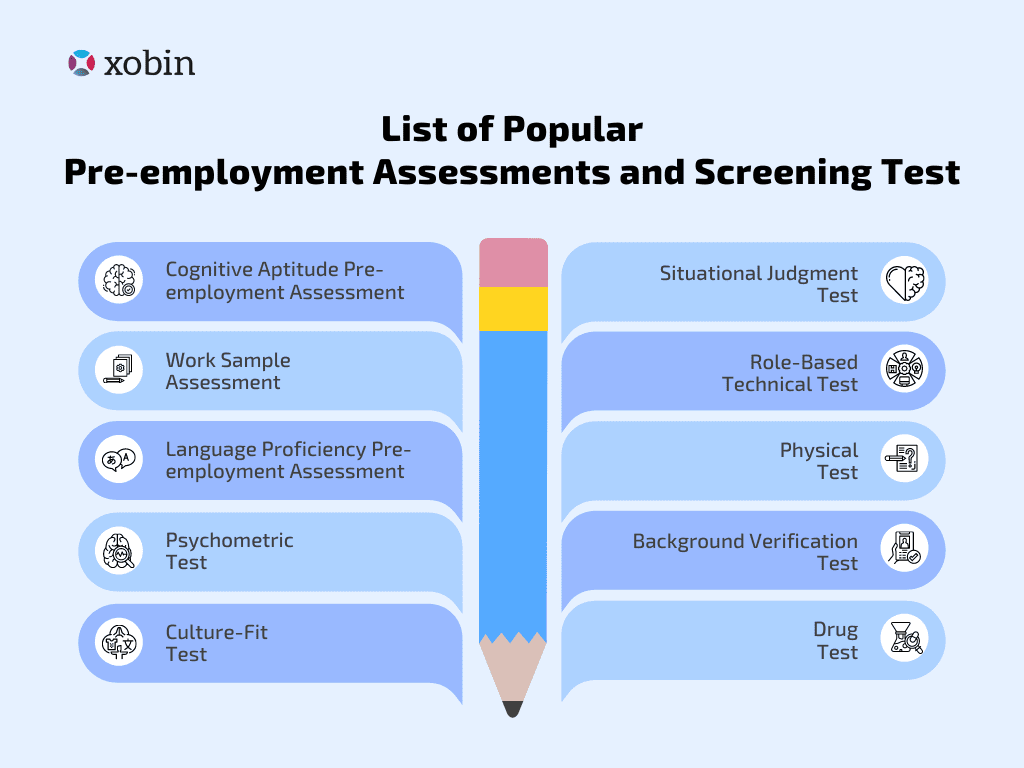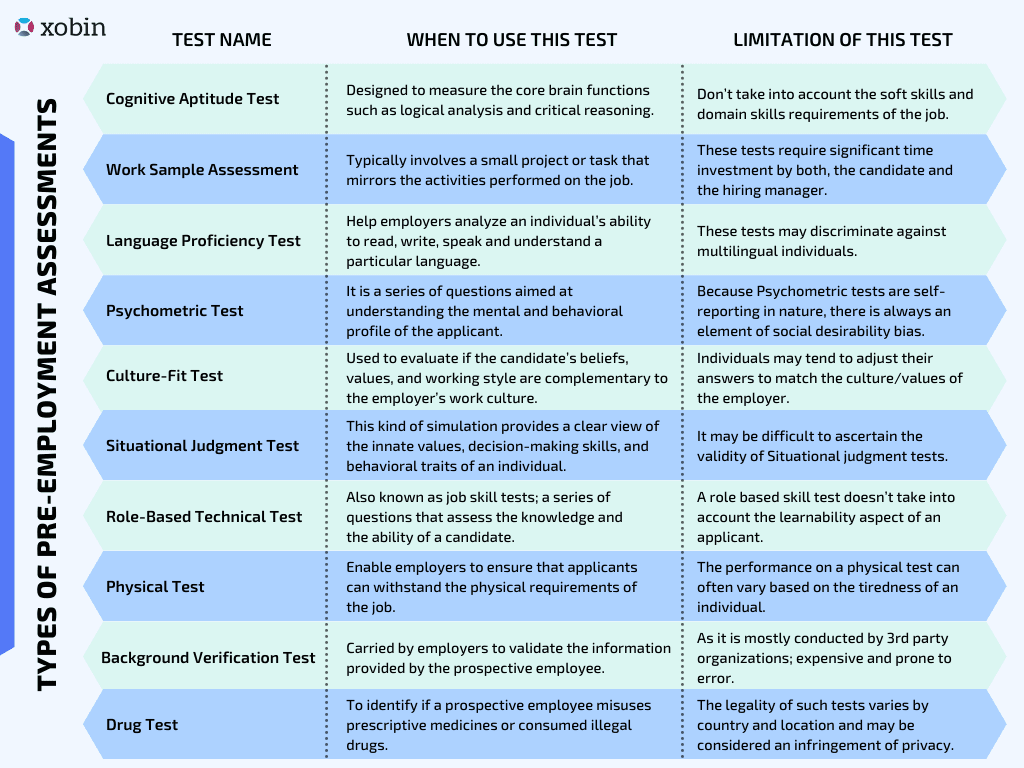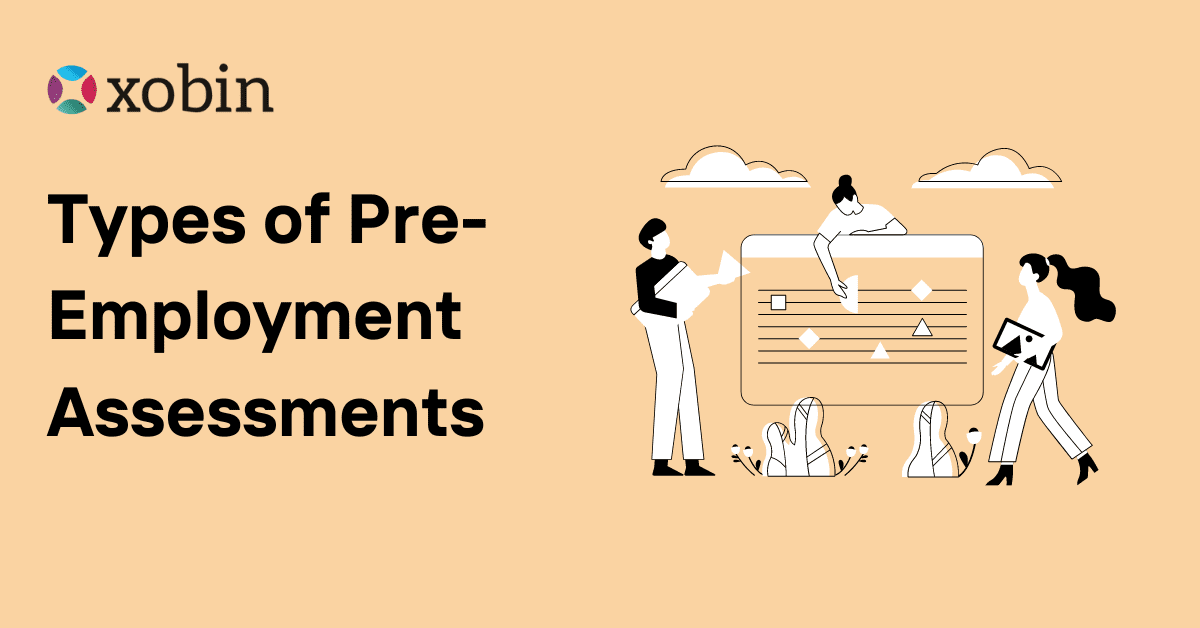In this article, we explore the different types of pre-employment tests and assessments. There is no ideal one-size-fits-all test. Each test works differently, having its own set of merits and limitations. To make informed hiring decisions, companies use Xobin’s Pre-Employment Testing to assess skills, cognitive abilities, and job readiness while understanding the objective behind each test along with its respective limitations.
Table of Contents
Most Common Types of Pre-employment Tests and Screening Assessments

1. Cognitive Aptitude Pre-employment Assessments
A cognitive aptitude pre-hire assessment is designed to measure the core brain functions such as memory, speed, attention, language comprehension, logical analysis, and critical reasoning. Moreover, aptitude tests are quick and standardized. Additionally, these tests are a good proxy for job performance for entry-level roles.
Limitation: Scores in aptitude tests can be improved with practice. While aptitude is a measure of mental ability, such tests don’t take into account the soft skills and domain skills requirement of the job.
2. Work Sample Assessment
A work sample assessment typically involves a small project or task that mirrors the activities performed on the job. The applicant gains a better context of the actual work, while employers get to see first-hand the work style and output.
Limitation: Work sample pre-employment assessments are long, and typically stretch for over 2 hours. These tests require significant time investment by both, the candidate and the hiring manager. The hiring manager would need to manually evaluate the work sample.
3. Language Proficiency Pre-employment Assessments
Language proficiency assessments, also known as linguistic tests, help employers analyze an individual’s ability to read, write, speak, and understand a particular language. There are various standardized levels for linguistic proficiency starting from A1 and A2 (Beginner) to C1 and C2(Proficient). Language tests may be critical for jobs having a client-facing role. They provide an ideal way for employers to ascertain the linguistic chops of an applicant, especially if the applicant is not a native speaker of the language.
Limitations: Language Proficiency tests may discriminate against multilingual individuals. Certain applicants may be proficient in using a language for writing, reading, and listening purposes. However, they may not be verbally fluent in the language.
4. Psychometric Test
A psychometric assessment is a series of questions aimed at understanding the mental and behavioral profile of the applicant. Many employers confuse psychometric tests with personality tests.
Limitations: Because psychometric tests are self-reporting in nature, there is always an element of social desirability bias. Psychometric testing are often confused with personality tests. and hence may choose to answer dishonestly due to fear of being misjudged. Secondly, there is no customization possible in psychometric assessments These tests need a lot of training and rigorous testing before they can achieve a certain level of validity. This might not always be economically viable for employers.
5. Culture Fit Test
The culture-fit test is a semi-structured interview or assessment to evaluate if the candidate’s beliefs, values, and working style are complementary to the employer’s work culture. Employers today understand that their success depends on building winning teams. In other words, when all members of a team align, they work like a symphony. On the flip side, poor culture fit would lead to tussles and ego clashes.
Limitations: Individuals may tend to adjust their answers to match the culture/values of the employer. It is not possible to truly identify the cultural fit of an applicant without working alongside them. The culture of an organization is constantly changing and hence a culture-fit test is always prone to error.
6. Situational Judgment Test
Situational judgment test commonly referred to as SJTs provides applicants with work-related scenarios and asks them how they would handle them. This kind of simulation provides a clear view of the innate values, decision-making skills, and behavioral traits of an individual.
Limitations: It may be difficult to ascertain the validity of situational judgment tests. Most employers prefer to run an in-house pilot in order to benchmark the scores before deploying these tests. This may increase the cost and time associated with SJTs. Moreover, in some cases, the situations provided as part of the test material may not be relatable to some candidates. For example, an outbound B2B salesperson may not relate to a question that involves B2C sales situations. This may affect the performance of candidates in such tests.
7. Role-Based Technical Test
Role-based technical tests, also known as job skill tests are a series of questions that assess the knowledge and ability of a candidate to perform the essential aspects of the job. For example, A software engineering skill test would comprise questions pertaining to coding and software languages, while a finance accountant skill test would comprise questions related to accounting practices, MS Excel, and bookkeeping. These tests are customized based on the job role.
Limitations: A role-based skill test doesn’t take into account the learnability aspect of an applicant. For example, an individual with solid fundamentals can be brought up to speed within 2 weeks. On the other hand, another individual may need 2 months to get started. A quick learner is more likely to outperform a slow one.
8. Physical Test
Pre-employment physical assessments enable employers to ensure that applicants can withstand the physical requirements of the job. For example, certain professions like forklift operators or truck drivers required the applicant to sit for 3-4 hours at a stretch. Others require physical strength and stamina.
Limitations: The performance on a physical test can often vary based on the tiredness of an individual. The average physical ability differs by age and gender. For instance, these scores are open to interpretation and hence are not bias-free. Therefore, employers must take a special effort to ensure that the test is EEOC compliant and is not discriminatory in nature.
9. Background Verification Test
Employers carry out a background verification to validate the information provided by the prospective employee. This includes academic records, previous employment details, addresses, and criminal records.
Limitation: Employers often need to rely on 3rd party organizations to conduct background verification. It is expensive and prone to error. Small errors in spelling or address may lead to incorrect data. Additionally, not all institutions and countries are data-savvy to digitize records. Lastly, in a few cases, lack of information may reflect negatively on the prospective applicant.
10. Drug Test
Employers use Pre-employment drug tests to identify if a prospective employee misuses prescriptive medicines or consumed illegal drugs. In most cases, applicants need to take up a drug test within 24 hours of receiving the offer letter.
Limitations of Drug Test: The legality of such tests varies by country and location. Moreover, it is a violation of privacy in some parts of the world. Although drug abuse is a sensitive subject, it may not be a true measure of competence for a job role.
We have consolidated all the different type of pre-employment assessments along with their best usecase and limitation. View the infographic

The Preferred Pre-Employment Assessment Software – Xobin
Each pre-employment assessment comes with its own unique use case and limitations. It’s best that employers use an established pre-employment testing tool like Xobin that offers validated, reliable tests developed by industry experts.
Xobin makes it extremely easy for employers to roll out pre-employment skill tests. After all, this means recruiters can finally look beyond resumes and quickly share tests with job applicants.






